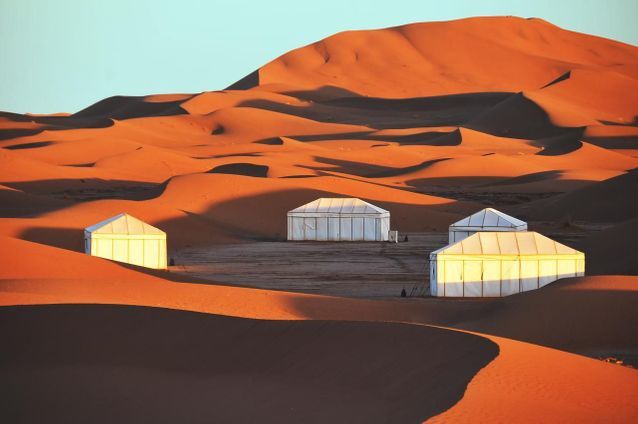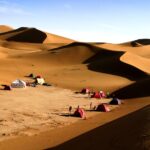
How to Stay Safe While Exploring the Chegaga Desert
Exploring the Chegaga Desert is an unforgettable adventure, offering stunning landscapes, towering sand dunes, and a chance to experience the serene beauty of the Sahara. However, as with any remote and extreme environment, safety should be your top priority. Proper preparation and knowledge can ensure your trip is both enjoyable and secure.
Here’s a comprehensive guide on how to stay safe while exploring the Chegaga Desert, whether you’re trekking, camping, or off-roading.
1. Plan Your Trip with a Trusted Guide
One of the most important steps for staying safe in the Chegaga Desert is to hire a professional guide or join an organized tour. The desert’s vastness and lack of clear landmarks make it easy to lose your way, even for experienced travelers.
Why this matters:
- Guides are familiar with the terrain and can navigate through unmarked trails.
- They know the safest routes and can adapt plans in case of changing weather conditions.
- They provide essential knowledge about local customs, wildlife, and emergency protocols.
Tip: Research tour operators thoroughly and choose a licensed, reputable guide with experience in the Chegaga region.
2. Pack Adequate Supplies
The desert is an unforgiving environment, and having the right supplies is critical. Always pack more water and food than you think you’ll need, as dehydration and hunger can quickly become dangerous.
What to pack:
- Water: At least 3-4 liters per person per day, plus extra in case of emergencies.
- Non-perishable food: High-energy snacks like nuts, dried fruit, and energy bars.
- First-aid kit: Include bandages, antiseptics, pain relievers, and any necessary personal medications.
- Sun protection: Sunscreen, sunglasses, a wide-brimmed hat, and lightweight, long-sleeved clothing to shield yourself from the sun.
- Navigation tools: A GPS device, compass, and physical map of the region.
Tip: Even if you’re traveling with a guide, carry your own essentials, especially water, as an added precaution.
3. Dress for the Environment
The Chegaga Desert experiences extreme temperature variations, with scorching hot days and chilly nights. Dressing appropriately can protect you from the harsh elements.
Key clothing tips:
- Wear light-colored, loose-fitting clothing during the day to stay cool and protect your skin from the sun.
- Bring warm layers for the evenings, as nighttime temperatures in the desert can drop significantly.
- Use durable, closed-toe shoes suitable for trekking on sand and rocky terrain.
Tip: Avoid synthetic fabrics that can trap heat. Opt for breathable materials like cotton or moisture-wicking fabrics.
4. Stay Hydrated and Know the Signs of Dehydration
Dehydration is one of the most common dangers in the desert. It’s vital to drink water regularly, even if you don’t feel thirsty.
Signs of dehydration:
- Dizziness or light-headedness.
- Dry mouth and dark-colored urine.
- Fatigue and confusion.
Prevention tips:
- Sip water consistently throughout the day, rather than drinking large amounts at once.
- Avoid alcohol and caffeinated drinks, as they can accelerate dehydration.
- Eat foods with high water content, like fruits, if available.
Tip: Carry oral rehydration salts or electrolyte tablets to replenish lost minerals.
5. Be Aware of Desert Wildlife
The Chegaga Desert is home to various animals, including snakes, scorpions, and insects. While encounters are rare, it’s essential to be cautious.
Safety tips:
- Avoid putting your hands or feet in places you can’t see, such as under rocks or inside crevices.
- Shake out your shoes and clothing before putting them on, especially in the morning.
- If bitten or stung, seek medical attention immediately.
Tip: Learn to identify common desert animals and understand how to react if you encounter them.
6. Protect Yourself from the Sun
The desert sun is intense, and prolonged exposure can lead to sunburn, heat exhaustion, or heatstroke.
How to stay protected:
- Wear sunscreen with a high SPF and reapply every 2-3 hours.
- Cover exposed skin with light clothing and wear a wide-brimmed hat.
- Take regular breaks in shaded areas or under a portable sunshade.
Tip: Avoid outdoor activities during the hottest part of the day, typically between 11 AM and 3 PM.
7. Be Prepared for Emergencies
The remote nature of the Chegaga Desert means that help may not be immediately available in case of an emergency. Being prepared can make all the difference.
Essential emergency items:
- Satellite phone or a device with GPS tracking for communication.
- Emergency whistle or signal mirror to attract attention.
- Spare batteries or power banks for electronic devices.
Tip: Share your travel itinerary with someone you trust before you leave, and check in with them periodically.
8. Understand Desert Weather Patterns
The weather in the Chegaga Desert can change rapidly, and being aware of the conditions can help you avoid potential dangers.
Key considerations:
- Watch for sandstorms, which can reduce visibility and make it difficult to breathe. Carry a scarf or bandana to cover your face in case of a storm.
- Be mindful of temperature extremes and adjust your activities accordingly.
- Check the weather forecast before your trip and stay updated through your guide or a reliable source.
Tip: If caught in a sandstorm, stay low to the ground and protect your face and eyes until it passes.
9. Respect the Environment and Local Communities
Finally, staying safe in the Chegaga Desert also means respecting the environment and local culture. Avoid activities that could damage the fragile desert ecosystem, and always follow the guidance of your hosts.
How to show respect:
- Dispose of waste properly or carry it out with you.
- Follow local customs and traditions, especially when visiting Berber villages.
- Support local businesses by purchasing souvenirs or booking tours with local operators.
Tip: A positive attitude and cultural sensitivity can enhance your experience and foster goodwill with the local community.
Conclusion
The Chegaga Desert is a place of incredible beauty and adventure, but it’s also a challenging environment that requires preparation and caution. By planning your trip carefully, packing the right supplies, and following safety guidelines, you can ensure a memorable and safe journey. Whether you’re trekking across sand dunes, camping under the stars, or exploring the desert’s unique culture, these safety tips will help you make the most of your Chegaga Desert adventure.



https://cr-v.su/forums/index.php?autocom=gallery&req=si&img=4016
Awesome https://is.gd/tpjNyL
Sprunki Incredibox is a brilliant evolution of the original-fresh beats and visuals make it a must-try for music lovers. Check out more creative games at Car Games.
Bài chia sẻ đúng tâm trạng dạo gần đây luôn!. Mấy hôm nay hot trend TikTok là ‘nổ hũ kiểu tỷ phú’, ai cũng bắt chước. Chứ không thì lại vào chiến vài ván ở jj win club, lúc căng stress cứ vào là quên hết buồn phiền 🎮 🔥
Only dare once again to make it!
https://the.hosting/
https://ping.space/
https://ufo.hosting/news
ionian yacht charter
https://auctionwheels.info/cars/ford/models/ecosport/pagination/start
https://t.me/s/TgGo1WIN/14
Официальный Telegram канал 1win Casinо. Казинo и ставки от 1вин. Фриспины, актуальное зеркало официального сайта 1 win. Регистрируйся в ван вин, соверши вход в один вин, получай бонус используя промокод и начните играть на реальные деньги.
https://t.me/s/Official_1win_kanal/1181
виртуальный номер телефона для телеграмма
by androxal online for cod
discount androxal canada suppliers
canadian pharmacy enclomiphene no prescription
how to order enclomiphene cheap in uk
discount rifaximin generic pharmacy online
rifaximin super best prices
buying xifaxan uk buy online
buy cheap xifaxan generic where to buy
online order staxyn generic online pharmacy
staxyn online prescription
buying avodart generic drug
cheapest buy avodart purchase uk
buying dutasteride usa generic
rx pharmacy online dutasteride
buy cheap flexeril cyclobenzaprine purchase online uk
female flexeril cyclobenzaprine no prescription canada
how to buy gabapentin how to purchase viagra
buy cheap gabapentin purchase england
purchase fildena generic london
ordering fildena cost insurance
buy itraconazole purchase from canada
online order itraconazole cheap drugs
kamagra s volným fedexem přes noc
jak dostat lékaře k předpisu kamagra
acheter kamagra fedex du jour au lendemain
pharmacie canadienne kamagra pas chère
order enclomiphene generic information
discount enclomiphene canada drugs
buy cheap androxal cheap real
cheapest generic androxal
qmthcm
pzca0y
d71d7y
https://shorturl.fm/fjPMd
Quite right! I like this idea, I completely with you agree.
g5w4ic
https://veented.ticksy.com/ticket/4499369
get french number https://virtual-local-numbers.com/countries/45-france.html
аренда яхты на сейшелах
**mindvault**
mindvault is a premium cognitive support formula created for adults 45+. It’s thoughtfully designed to help maintain clear thinking
4z43kc
My thoughts exactly.
You are not right. I can prove it. Write to me in PM, we will talk.